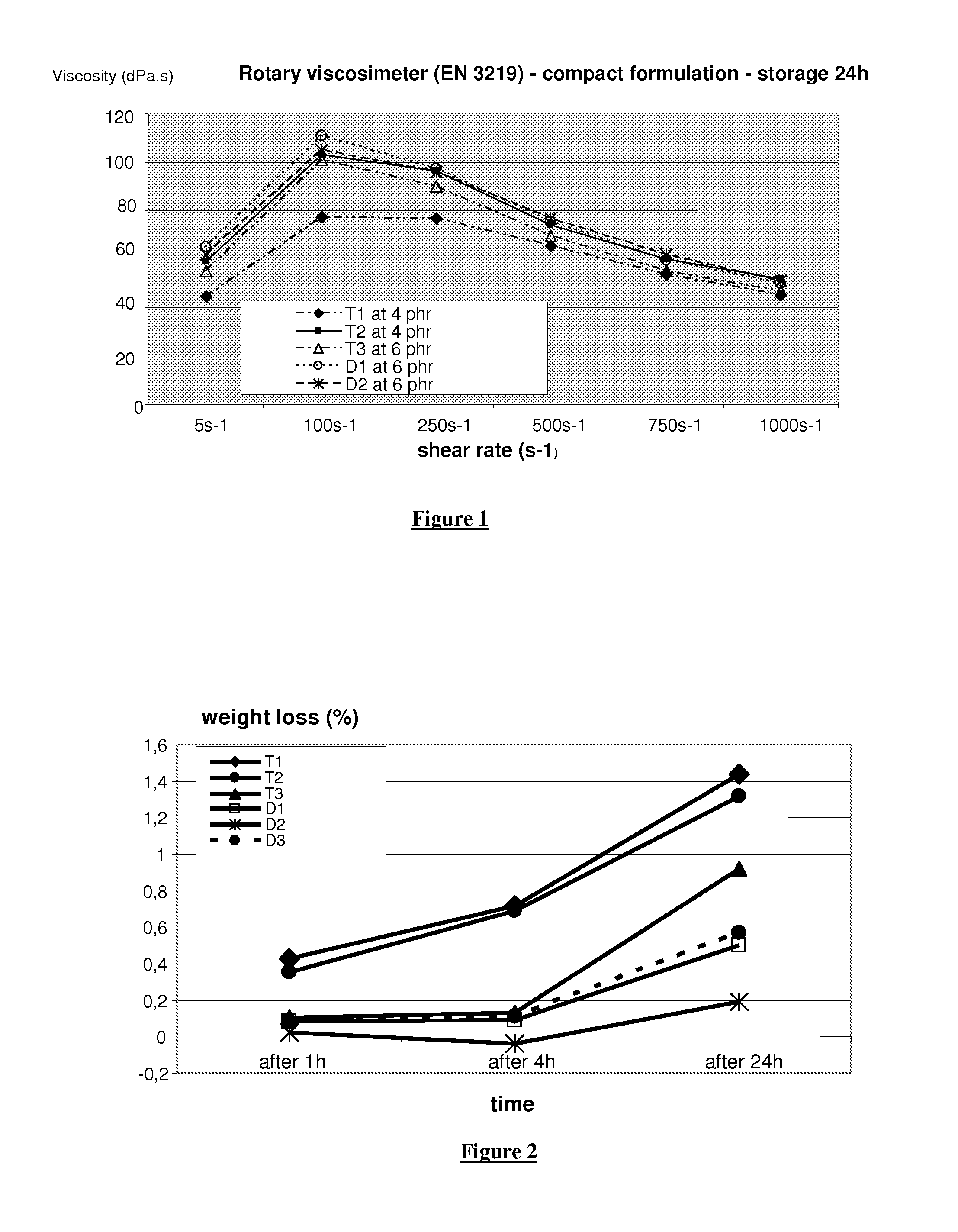Hydrocarbon diluent with a low VOC level for construction materials
a technology of voc level and diluent, which is applied in the direction of hydrocarbon structural skeleton modification, electrical apparatus, basic electric elements, etc., can solve the problems of increasing increasing the amount of materials used, and becoming a source of emissions that are often toxic to the environment and more particularly to human and animal health. , to achieve the effect of facilitating the handling of materials and lowering the viscosity of materials
- Summary
- Abstract
- Description
- Claims
- Application Information
AI Technical Summary
Benefits of technology
Problems solved by technology
Method used
Image
Examples
example 1
[0040]The present example describes the various diluents used comprising those of the prior art with reference Ti and those of the invention with reference Di and their comparative use in formulations of PVC paste. The diluents of the prior art are white spirit (T1), kerosene (T2), dodecylbenzene (T3) and finally a hydrocracked gas-oil cut (T4) of cut 300° C. and above. The diluents of the invention are two products derived from the distillation of a hydrodewaxed cut 280-450° C., D1 corresponding to a cut 290-380° C. and D2 to a cut distilling at above 340° C. A third diluent D3 corresponds to a mixture of 70% by weight of diluent D1 with 30% of T4.
[0041]Table 1 below presents the characteristics of all of the diluents tested.
TABLE 1TestmethodUnitT1T2T3T4D1D2D3Initial boilingASTM D86° C.182233280305289334295pointFinal boilingASTM D86° C.216264310347373378380pointDistillation ° C.34313042844485rangeViscosity ASTMmm2 / s1.73.31117.721.413.0at 20° C.D445Viscosity ASTMmm2 / s2.35.56.17.710....
example 2
[0049]This example gives a comparison of the performance of a formulation of PVC paste using the diluents according to the invention with those using diluents of the prior art. This formulation is that of a floor covering containing PVC resins marketed by ARKEMA. This particular formulation contains:
TABLE 5PVC resinLacovyl PB170480phrPVC resinLacovyl PS106020phrPlasticizerphthalate family37phrStabilizerorganometallic complex*2.5phrco-stabilizerepoxidized vegetable base2phrdiluent to beT1, T2, T3, D1, D22-2.5-3phr**evaluated*for example Al, Sn, Ti, Zn carboxylate**depending on the diluent in order to keep the same viscosimetric profile in all cases.
[0050]For this formulation the measurements comprised the deaeration performance, the thermal stability of the paste, optical and mechanical properties, the volatility of the paste at 70° C. and finally the VOC emissions from the paste.
[0051]The Deaeration Behaviour:
[0052]Samples of PVC paste prepared from the various diluents are placed u...
example 3
[0071]This example describes the use of diluents according to the invention in silicone mastics, particularly in the silicone mastics RTV-1 (Room Temperature Vulcanizable−1 component). The following table shows the typical composition of this type of mastic:
Silicone polymer51.15%Plasticizer34.10%silicone oilq.s.hydrocarbon solventHC %Crosslinking agent4.74%silica10.00%catalyst0.01%
[0072]In this composition, the polymer / plasticizer ratio is 1.5 / 1 and the sum of hydrocarbon solvent (HC %)+silicone oil (q.s.) is equal to 34.1% by weight.
[0073]In Table 13 below, the amount of hydrocarbon solvent or HC is varied up to the limit of compatibility with the polymer and the loss of volume is measured according to standard ISO 10563 (after 7 days at 70° C.), this loss of volume being connected with evaporation of the lightest fractions of the plasticizers and ingredients used in the formulation, in particular including the VOCs. The larger the amount of VOC compounds in the mixture, the greate...
PUM
| Property | Measurement | Unit |
|---|---|---|
| boiling point | aaaaa | aaaaa |
| pour point | aaaaa | aaaaa |
| pour point | aaaaa | aaaaa |
Abstract
Description
Claims
Application Information
 Login to View More
Login to View More - R&D
- Intellectual Property
- Life Sciences
- Materials
- Tech Scout
- Unparalleled Data Quality
- Higher Quality Content
- 60% Fewer Hallucinations
Browse by: Latest US Patents, China's latest patents, Technical Efficacy Thesaurus, Application Domain, Technology Topic, Popular Technical Reports.
© 2025 PatSnap. All rights reserved.Legal|Privacy policy|Modern Slavery Act Transparency Statement|Sitemap|About US| Contact US: help@patsnap.com


